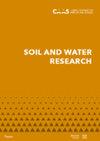Implications of surfactant application on soil hydrology, macronutrients, and organic carbon fractions: An integrative field study
IF 1.7
4区 农林科学
Q4 SOIL SCIENCE
引用次数: 0
Abstract
This study investigates the effects of repeated applications of the non-ionic soil surfactant H2Flo (ICL-SF Inc., Israel) on the soil water content, hydraulic conductivity, nutrient distribution, and organic carbon fractions (OCFs) in non-hydrophobic loamy sand soils under subsurface drip irrigation. Our results indicate that H2Flo treatment reduces both saturated and unsaturated hydraulic conductivity while promoting the uniform irrigation distribution, consistent with previous findings on surfactants’ effects on sandy soils. An increase in soil pH levels, organic carbon content, and extractable magnesium, calcium, and potassium was observed in treated soils, with elevated levels of potassium permanganate oxidizable organic carbon (POXC) implying accelerated decomposition rates. Notably, a positive linear relationship was found between POXC and the increased NO3–-N content of treated soils, suggesting induced conditions of nitrification. However, the carbon fractions water-soluble organic carbon (Cws) and hot water-soluble organic carbon (Chws) remained quantitatively unchanged, even though they exhibited a positive linear relationship with the soil’s hydraulic conductivity. The study highlights the crucial role of monitoring changes in OCFs and nutrient dynamics after surfactant application to optimize soil organic matter utilization and chemical fertilizer management.表面活性剂对土壤水文、常量养分和有机碳组分的影响:一个综合的实地研究
本研究考察了ofÂ重复施用ofÂ非离子型土壤表面活性剂H2Flo (ICL-SF Inc., Israel) onÂ对地下滴灌条件下土壤含水量、导电性、养分分布和有机碳组分(ocf)的影响inÂ非疏水性壤土砂土。我们的研究结果表明,H2Flo处理降低了饱和和非饱和的导电性,同时促进了均匀的灌溉分布,与先前的研究结果一致onÂ表面活性剂的作用onÂ沙土。AnÂ增加inÂ土壤pH值,有机碳含量,可提取的镁、钙和钾在inÂ处理的土壤中被观察到,ofÂ高锰酸钾可氧化有机碳(POXC)水平升高意味着分解速度加快。值得注意的是,POXC与处理土壤NO3—NÂ含量的增加ofÂ之间存在aÂ正线性关系,提示诱导条件ofÂ硝化作用。碳组分水溶性有机碳(Cws)和热水溶性有机碳(Chws)与土壤导水率呈aÂ正线性关系,但在数量上保持不变。研究强调了表面活性剂施用后ofÂ监测变化in OCFs和养分动态toÂ对土壤有机质利用和化肥管理的重要作用。
本文章由计算机程序翻译,如有差异,请以英文原文为准。
求助全文
约1分钟内获得全文
求助全文
来源期刊

Soil and Water Research
Water resources, Soil Science, Agriculture-WATER RESOURCES
CiteScore
4.60
自引率
0.00%
发文量
26
审稿时长
>12 weeks
期刊介绍:
An international peer-reviewed journal published under the auspices of the Czech Academy of Agricultural Sciences and financed by the Ministry of Agriculture of the Czech Republic. Published since 2006.
Thematic: original papers, short communications and critical reviews from all fields of science and engineering related to soil and water and their interactions in natural and man-modified landscapes, with a particular focus on agricultural land use. The fields encompassed include, but are not limited to, the basic and applied soil science, soil hydrology, irrigation and drainage of lands, hydrology, management and revitalisation of small water streams and small water reservoirs, including fishponds, soil erosion research and control, drought and flood control, wetland restoration and protection, surface and ground water protection in therms of their quantity and quality.
 求助内容:
求助内容: 应助结果提醒方式:
应助结果提醒方式:


